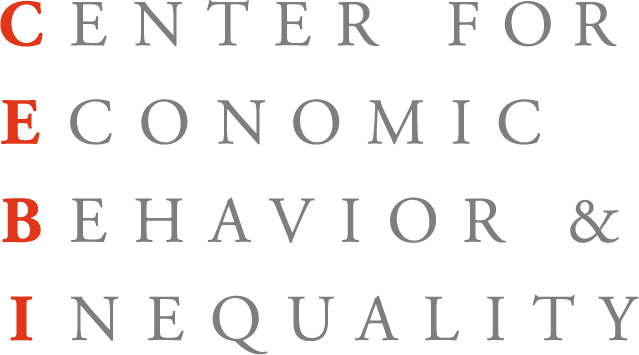| |
|
Social Position and Fairness
Views
with
Kristoffer Balle Hvidberg (CEBI) and Stefanie
Stantcheva (Harvard)
NBER Working Paper No. 28099, 2020.
Download Paper
Social Selection and
Influence Together Produce Strong Homophily in the
Generosity of Couples
with
Felix Sebastian Døssing, David Dreyer Lassen and
Peer Ebbesen Skov
Work in progress
Linking Changes in
Inequality in Life Expectancy and Mortality:
Evidence from Denmark and the United States
with
Gordon B. Dahl, Torben Heien Nielsen and Benjamin Ly
Serena
NBER Working
Paper No. 27509, 2020
Download Paper
How Do Households Respond to
Unemployment Shocks? Lessons From Multiple
High-Frequency Data Sets
with
Asger Lau Anders, Amalie sofie Jensen, Niels
Johannesen, Søren Leth-Petersen and Adam Sheridan
Working
paper, April
2020
Download Paper
The marginal interest rate is the rate of
interest at which a household can access
additional liquidity. Consumption theory posits
that variation in marginal interest rates
across consumers predicts differences in the
propensity to spend a stimulus payment. This
hypothesis is directly tested in the context of
a Danish 2009 stimulus policy that transformed
illiquid pension wealth into liquid wealth. The
analysis is based on administrative records
with account level information about loans and
deposits to derive a household level measure of
the marginal interest rate, which is merged
with survey data collected specifically to
measure the spending response to the stimulus
policy. The data reveal substantial variation
in marginal interest rates across consumers,
and these interest rates predict spending
responses.
We use Danish wealth records from three decades
to characterise wealth inequality in childhood,
where the main source of wealth is transfers.
Wealth holdings are small in childhood, but they
have strong predictive power for future wealth
in adulthood. At age 18, asset holdings of
children are more informative than parental
wealth in predicting wealth of children when
they are in their 40s. We investigate why and
rule out that childhood wealth in itself can
accumulate enough to explain later wealth
inequality. Instead, childhood wealth seems to
proxy for intergenerational correlation in
savings behaviour and additional transfers from
parents.
This paper documents a strong relationship between birth endowments of parents and the
cognitive development of their children. The association between maternal birth weight and child
school test scores corresponds to 80 percent of the association between the child's own birth
weight and test scores (both in univariate and multivariate settings). We find a strong
relationship, even when controlling for family differences, by looking at birth weight variation
between sisters and the test score outcomes of their children, and when controlling for parental
education and economic resources. Child test scores are also strongly related to paternal birth
weight. To assess external validity, we replicate recent results from the US on the relationship
between child birth weight and test scores. Our intergenerational results suggest that inequality
in birth endowments may be important for inequality in key outcomes of the next generation.
Do people end up in financial trouble simply because of adverse shocks to income and wealth, or
is financial trouble related to persistent differences in financial attitudes and behavior that may
be transmitted from generation to generation? We address this question using a new administrative
data set with longitudinal information about defaults for the universe of personal loans
in Denmark. We provide non-parametric evidence showing that the default propensity is more
than four times higher for individuals with parents who are in default compared to individuals
with parents not in default. This intergenerational relationship is apparent soon after children
move into adulthood and become legally able to borrow. The intergenerational relationship
is remarkably stable across age groups, levels of loan balances, parental income levels, childhood
school performance, time periods and different measures of financial trouble. Basic theory
points to three possible explanations for the correlation across generations in financial trouble:
(i) children and parents face common shocks; (ii) children and parents insure each other against
adverse shocks; (iii) financial behavior differs across people and is transmitted across generations.
Our evidence indicates that the last explanation is the most important. Finally, we show that
the intergenerational correlation in financial trouble is not fully incorporated in interest setting
on loans, pointing to the existence of an interest rate externality in the market for personal loans.
Intergenerational Wealth Mobility: Evidence
from Danish Wealth Records of Three Generations
with
Simon Halphen Boserup and
Wojciech Kopczuk
October 2015
[+] Show Abstract
Download Paper
This paper provides novel insights on intergenerational wealth mobility using Danish wealth
records. Non-parametric evidence reveals an almost linear relationship between wealth ranks
of children and parents with a slope of 1/4, except at the very top of the distribution where
the slope is much higher. The wealth relationship is surprisingly stable across subsamples and
after controlling for key socioeconomic outcomes. This is consistent with a unidimensional
latent factor governing a substantial part of the complicated underlying wealth dynamics and
wealth of past generations summarizing almost all relevant information when predicting child
wealth. Wealth of grandparents has very strong explanatory power conditional on any level of
parental wealth showing that standard two-generation measures severely understate the extent
of intergenerational persistence in wealth formation.
|
